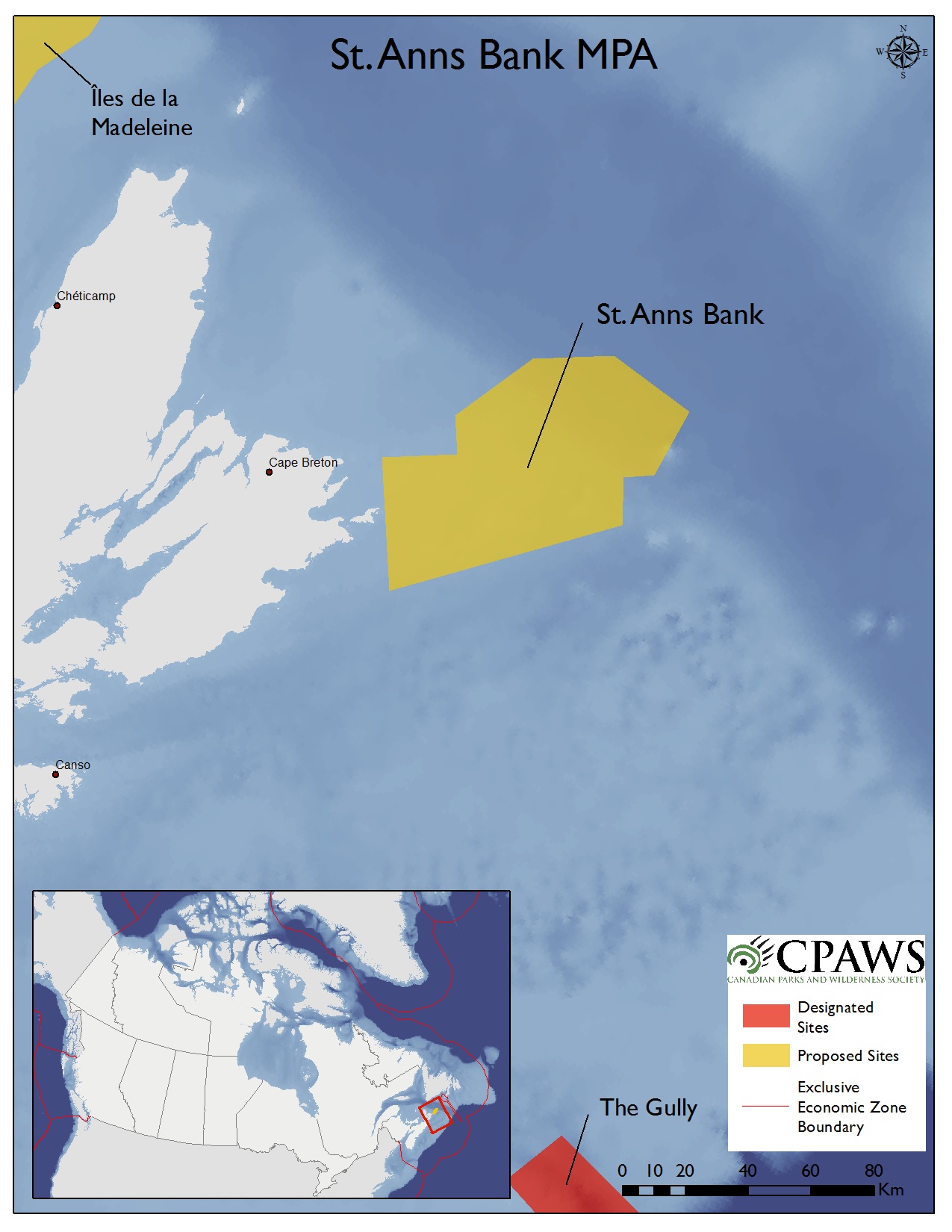
HALIFAX – The Nova Scotia Chapter of the Canadian Parks and Wilderness Society (CPAWS) welcomed today’s announcement by the federal government that it will designate St. Anns Bank as a marine protected area.
“We are very pleased to see the government of Canada make this announcement. With the high standards of protection proposed for St. Anns Bank, this marine protected area will make an important contribution to Canada’s target of protecting 10% of our ocean by 2020” said Sabine Jessen, CPAWS’ National Ocean Program Director.
St. Anns Bank Marine Protected Area is located off the coast of Cape Breton near Scatarie Island. It will be 4,364 km2 in size and is an important location for leatherback sea turtles, as well as deep-sea corals and sponges. It also contains biologically productive areas, as well as representative marine ecosystems typical of shelf, slope, and channel habitats.
“This will be the largest marine protected area in Nova Scotia, and the first one established here in over a decade”, said Chris Miller, National Conservation Biologist for CPAWS, based in Nova Scotia. “We appreciate the steps that the federal government is taking to increase the amount of ocean dedicated toward conservation.”
Less than 1% of Canada’s oceans are currently designated as marine protected areas, and significantly less than that is entirely off-limits to industrial activities.
“We have a long way to go to catch up”, said Miller. “St. Anns Bank is an important site for conservation on its own, but it also moves Canada in the right direction toward achieving our national biodiversity conservation targets”.
The federal government released the proposed regulations for St. Anns Bank MPA on December 16th, 2016, through the publication of Canada Gazette Part 1.
Those regulations show that the entire MPA will be off-limits to oil and gas activities, as well as bottom-trawling. Three zones will be created where existing fisheries are permitted to occur, including snow crab, lobster, and halibut. These regulations are consistent with the final recommendations of the St. Anns Bank Advisory Committee.
Miller participated on the advisory committee that provided recommendations to the federal government for protecting St. Anns Bank. That committee included First Nations, Provincial and Federal government representatives, academics, industry associations, and environmental groups. Those discussions concluded successfully in 2013.
“There was a lot of give and take at those meetings,” said Miller. “It was important for everyone to take the time to listen to each other’s concerns and to try to find solutions to the challenges that arose. That doesn’t mean everyone received everything they were asking for, but I think it did place St. Anns Bank on a better path toward successful implementation.”
Through those meetings adjustments were made to the northern border of the St. Anns Bank Area of Interest to lessen impacts on fishing and oil and gas interests, but the boundary was expanded in the southeast to provide additional habitat protections.
“St Anns Bank sets a good benchmark for what Canada can achieve,” said Sabine Jessen, CPAWS’ National Ocean Program Director, “at a time when we are seeing proposals for other sites like the Scott Islands marine National Wildlife Area in British Columbia that allow harmful activities like bottom trawling to continue without any restrictions, St. Anns Bank proves Canada can create good quality marine protected areas”.
The publication of Canada Gazette Part 1 initiates one final round of public consultation before the regulations for the marine protected area are official.
St. Anns Bank was first proposed as a potential marine protected area in 2010 and officially selected as an “Area of Interest” in 2011. Negotiations with stakeholders were completed in 2013.
CPAWS has consistently raised concerns about the slow pace of marine protected area designations in Canada, as well as the generally low standards of protection in Canada’s marine protected areas.
“From beginning to end, the process for St. Anns Bank has taken almost seven years”, said Miller. “We can’t continue to designate marine protected areas at such a slow pace, given how far behind we have slipped compared to other nations. Fortunately, the Department of Fisheries and Oceans seems keen on achieving its conservation targets and is now taking a more systematic approach to selecting multiple sites for a network of marine protected areas.”
Contact:
Sabine Jessen
CPAWS National Director, Oceans Program
[email protected]
(604) 657-2813
Chris Miller
CPAWS National Conservation Biologist
cmiller@localhost
902-880-0726
St. Anns Bank marine protected area (Map credit: CPAWS)